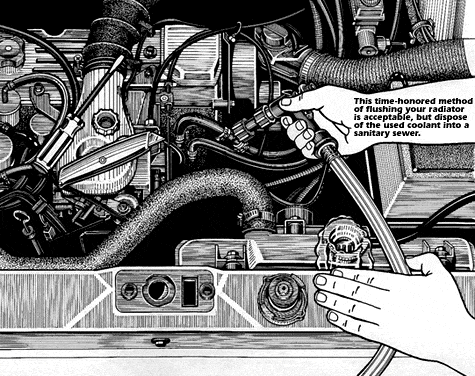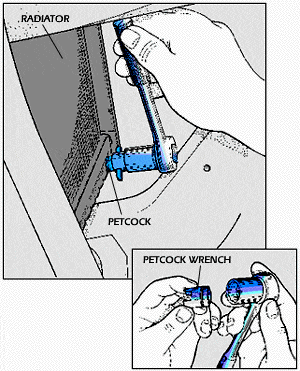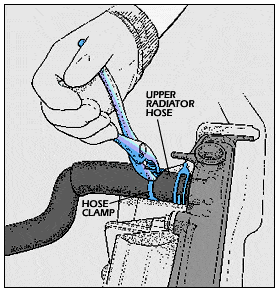here's a few links,
concerning cleaning out a radiator that might have become rather restrictive to flow of coolant over a few years,if your car runs hot,
one potential reason is a partially clogged radiator,
back when I was younger (1950s-late 1960s)
it was rather common knowledge that you could clear a good deal of crud from the interior of the radiator of a car,
if you drained the old anti-freeze, flushed it out by disconnecting the lower radiator hose and draining as much coolant as possible,
you then re-connected the lower radiator hose, poured a gallon of white vinegar into the radiator, finish filling it with water
, and let the car run for 15-20 minutes, turn it off, let it cool and then re-drain the radiator, by temporarily removing and reconnecting the lower radiator hose, re-flush for 15 minutes with a garden hose, stuffed in the radiator and the upper hose allowed to puke fluid out of the engine as in ran, for 15 minutes.
now Im fairly sure many of you are thinking ANTIFREEZE is supposed to prevent corrosion,
and in theory thats correct, but with aluminum and iron combo engines,
thats not always 100 % true.
Im sure theres a dozen laws against allowing any trace of antifreeze to get on the pavement or ground now, so be sure to drain the antifreeze and dispose of it correctly, remember pets will get injured if they drink water containing anti-freeze.
https://gobdp.com/blog/what-is-the-best-way-to-flush-a-radiator/
https://cartreatments.com/tips-to-flush-a-car-radiator/
https://www.popularmechanics.com/cars/how-to/a78/1272246/
https://itstillruns.com/clean-car-radiator-vinegar-6436046.html
http://garage.grumpysperformance.com/index.php?threads/anodes.74/#post-35559
concerning cleaning out a radiator that might have become rather restrictive to flow of coolant over a few years,if your car runs hot,
one potential reason is a partially clogged radiator,
back when I was younger (1950s-late 1960s)
it was rather common knowledge that you could clear a good deal of crud from the interior of the radiator of a car,
if you drained the old anti-freeze, flushed it out by disconnecting the lower radiator hose and draining as much coolant as possible,
you then re-connected the lower radiator hose, poured a gallon of white vinegar into the radiator, finish filling it with water
, and let the car run for 15-20 minutes, turn it off, let it cool and then re-drain the radiator, by temporarily removing and reconnecting the lower radiator hose, re-flush for 15 minutes with a garden hose, stuffed in the radiator and the upper hose allowed to puke fluid out of the engine as in ran, for 15 minutes.
now Im fairly sure many of you are thinking ANTIFREEZE is supposed to prevent corrosion,
and in theory thats correct, but with aluminum and iron combo engines,
thats not always 100 % true.
Im sure theres a dozen laws against allowing any trace of antifreeze to get on the pavement or ground now, so be sure to drain the antifreeze and dispose of it correctly, remember pets will get injured if they drink water containing anti-freeze.
https://gobdp.com/blog/what-is-the-best-way-to-flush-a-radiator/
https://cartreatments.com/tips-to-flush-a-car-radiator/
https://www.popularmechanics.com/cars/how-to/a78/1272246/
https://itstillruns.com/clean-car-radiator-vinegar-6436046.html
http://garage.grumpysperformance.com/index.php?threads/anodes.74/#post-35559
Step 1
Place a shallow pan under the radiator to catch the coolant you are draining. Do not allow the coolant to soak into the ground, as there are regulations regarding the proper disposal of coolant and antifreeze.
Step 2
Remove the radiator cap and loosen the radiator drain valve to allow all of the coolant to drain into the pan.
Step 3
Refill the radiator halfway with water. Add a gallon of white distilled vinegar. Fill the rest of the way up with water.
Step 4
Replace the radiator cap and start the car. Let the car run for several minutes to reach normal temperature.
Step 5
Leave the car to sit overnight. Drain the radiator by removing the radiator drain valve. As its contents are draining, use the hose to flush out the radiator.
Fill the radiator with the proper mixture of coolant and water for your vehicle.
Tip
Items you will need
- Call your local waste disposal company to find out how to properly dispose of coolant or antifreeze.
- Large shallow pan
- 1 gallon white distilled vinegar
- Hose
- Water
- Coolant
How to Flush Your Radiator and Cooling System
Keeping your vehicle from overheating requires regular maintenance of your cooling system. This will extend the life of your vehicle and prevent roadside emergencies.
By Mike Allen
Feb 8, 2017

EVELYNGIGGLES - FLICKR CC
You take off the cap and look at the coolant. It's a nice shade of green, or maybe red, or maybe even orange. It looks good. Should you leave it in? Unless it's colored orange, the answer is no, especially if it's been two years or more since the last time you drained it.

MORE FROM POPULAR MECHANICS
Racing an Electric Skateboard vs. The Subway
Current Time 0:46
Loaded: 56.74%
Remaining Time -2:26
Today's engines are loaded with aluminum components: cylinder heads, water pumps, manifolds, even engine blocks. And the two primary heat exchangers–radiator and heater–are also aluminum. Aluminum needs great corrosion protection to survive, and the corrosion protection in green and red antifreeze is used up in about two years. Orange offers longer life, but if your car came with green or red, you can't switch to orange without a fair amount of preparation. And if your car is much more than four years old, a switch is not likely to yield long-term coolant life–you'd still face the usual 2-year drain interval.
Drain the Coolant
First, let's do a proper job of draining the coolant. Start by checking the specs to see how much is in the system. This is important, because capacities vary all over the lot. Some Toyota Fours and V6s, for example, hold only about 5 1/2 quarts. Other systems hold 14 to 18 quarts. This way, you'll know what percentage of the coolant drains out.
Start with a cool engine. If the pressure cap is on the engine or radiator, look at the overflow reservoir, and if it's easy to disconnect and empty, go ahead. Then, remove the radiator cap and open the radiator drain cock. If the drain cock is in tight quarters, use a special socket available at most auto parts stores. Let the coolant drain into a pan. Unless your town has a coolant collection setup, pour the old antifreeze into a household drain, clothes-washer pipe or a toilet. That's an environmentally safe approach. Don't pour it on the ground or into a storm sewer. If your car has a copper radiator or heater core, the coolant is contaminated with lead solder. Many municipalities have hazardous-waste disposal facilities that will take it. Also, in most of the United States it's illegal for professional mechanics to dispose of used coolant, so you may be able to take it to the local shop and ask if they'll handle it.
Next, move the dashboard temperature lever to hot, so if your car happens to have a heater coolant control valve, it will open. If the pressure cap is on the plastic reservoir, remove the cap, then open the drain cock. No radiator drain cock? Disconnect the lower radiator hose from the radiator. Move the hose clamp back from the radiator neck, slip a thin screwdriver between the hose end and radiator neck to free up the hose, then twist slightly to disconnect the hose. Draining the radiator alone normally should remove 40 to 45% of the coolant. After the first drain, fill the system as well as you can with water, then warm up the engine and let it cool. Drain the radiator again and fill it once more with water. Repeat.
ADVERTISEMENT - CONTINUE READING BELOW
Bleed the System
Now comes the hard part–filling the system. If the system holds 12 quarts, you want to install 6 quarts of undiluted antifreeze, or exactly half of the cooling system's capacity.
The cooling system has lots of nooks and crannies that trap air, making it difficult to fill the system with coolant. The fill cap and neck are supposed to be at the high point of the system to help air bleed out, but often they aren't. And even if they are, you need all the natural help you can get. So jack up the front of the car, which gets the coolant fill neck as high as possible.
Check for air bleeds on the engine. Sometimes you'll see an obvious air bleed, such as a boltlike item threaded into a hose. If there's an air bleed, open it. If there are several, open them all. If you have access to a factory service manual or PM CD-ROM for your car, check it for a coolant fill procedure.
Pour in the required amount of antifreeze slowly until you see coolant oozing out of the open air bleeds. Then close the bleeds and top off the system with the remaining antifreeze and then plain water.
If the system has a heater coolant valve, close it by moving the temperature control lever or knob to cold. With the engine running at fast idle and warmed up, have a helper move the lever or knob to hot while you listen at the coolant valve. If after the first rush of coolant you hear a continuous gurgling noise, there's still air in the coolant, and you should be prepared to watch the coolant level in the reservoir over the next few weeks.

http://garage.grumpysperformance.com/index.php?threads/replacing-a-early-c4-corvette-radiator.15833/


Pick the Antifreeze
Most antifreeze is made with a base chemical called ethylene glycol. Green dye is used in most brands, except Toyota, which uses red. Extended-life antifreezes, also with green dye, were on the market until two years ago. But the newest entry is a superlong-life antifreeze with a totally new rust/corrosion inhibitor developed originally for heavy-duty use (such as trucks). The original, from Texaco (used as original equipment by GM), is called Dex-Cool. The latest is Prestone Long Life 5/100. These two are orange.
The rust/corrosion inhibitors vary, but if antifreeze is green, assume that its life in a car with a lot of aluminum components is two years or 30,000 miles–whichever comes first. You can push that to a third year if the engine is all cast-iron. "Toyota Red" is a specific formula, but if you drain it, you can replace it with any name-brand American formula. Here again, the replacement interval is two years or 30,000 miles.
The inhibitors in orange antifreeze are not chemically compatible with what's in green or red. However, if you have at least 5000 miles on the green, the chemical bond with the aluminum components is "solid." So if you want to get extended life with a coolant installation, just do a thorough drain-by-dilution, at least three times. The coolant you drain out should be virtually clear, like the color of water. If it's still green, you have to repeat the process until it's all out.
With the radiator and reservoir drained, pour in the amount of antifreeze necessary–there should be plenty of room–and then top up with water. Follow the procedures we've discussed to ensure a full system.
Remember: You can do this only as a maintenance procedure, not as a final step when replacing a part, such as the water pump and radiator.
What about "pet-friendly" or "safer" antifreezes made with a base of propylene glycol? The name brands (Sierra and Prestone Lo-Tox) will do the same job as ethylene glycol. But they cost a little more and actually require a greater quantity to provide the same freeze protection, and in truth, they're only a bit less hazardous.
They aren't sweet, and consequently aren't as likely to be consumed by toddlers or pets. Don't rely on this, however. Store all unused coolant, low-tox or not, safely. Dispose of all drained coolant in a sanitary sewer and sweep up or rinse away any spillage.


A coolant pump, or water pump, circulates the antifreeze and water mixture between the engine and the radiator. After the coolant circulates through the engine, the pump pushes it out the upper radiator hose into the radiator, a heat exchanger made of metal tubes (aluminum on today's cars) to which fins are attached. The fins draw away heat and dissipate it to the air that is drawn through the radiator by fans and the forward motion of the car. The cooled coolant is drawn from the radiator through the lower radiator hose and back into the engine by the pump, and the cycle starts all over again.
When the engine is cold, coolant circulates only within the engine, so engine heat warms it up faster. At about 195 degrees F, the coolant heats a temperature-sensitive valve (the thermostat) that opens to allow the coolant to flow through the radiator. The thermostat may be located at the engine outlet, in line with the upper radiator hose, or at the inlet to the water pump (the preferred location on today's cars).
The coolant also flows through hoses into and out of the heater, which, like a miniature radiator, gives up its heat to the surrounding air. In this case, however, the heated air is blown into the passenger compartment.
Raising the cooling system's pressure also raises the coolant's boiling point, so the radiator cap (which also could be on the engine or on the separate reservoir) has a pressure valve to raise the pressure in the cooling system by about 15 psi. This increases the boiling point of the coolant by about 40 degrees F. So, the boiling point of a 50/50 mix of antifreeze and water in a properly functioning system is about 265 degrees F or higher.
MORE FROM
How to Flush Your Radiator and Cooling System
Keeping your vehicle from overheating requires regular maintenance of your cooling system. This will extend the life of your vehicle and prevent roadside emergencies.
By Mike Allen
Feb 8, 2017
Last edited:
